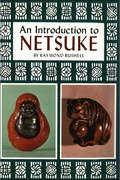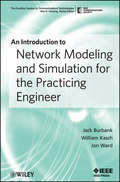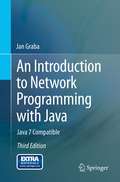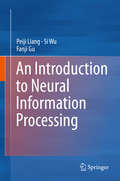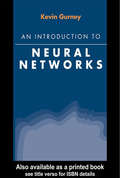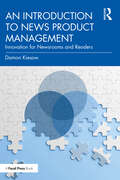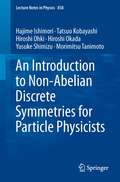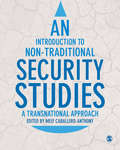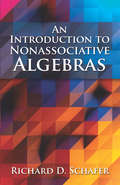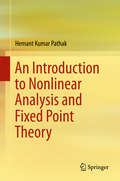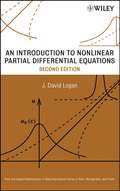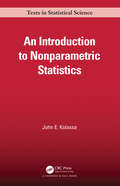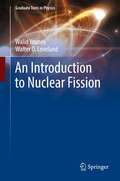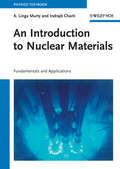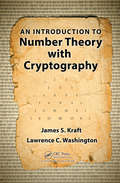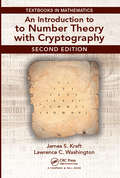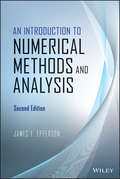- Table View
- List View
An Introduction to Netsuke
by Raymond BushellWith dozens of photos and illustrations, A Introduction to Netsuke is a readable and thorough guide to Japanese miniature art.Among the many Japanese fine arts, few have aroused greater admiration than the netsuke. This miniature piece of Japanese sculpture, approximately 1 1/2 inches in size, was designed (in the absence of pockets on kimonos) as an aid in suspending articles such as tobacco pouches from the sash of a kimono. It developed in ancient times as a utilitarian object, but became in the 16th century an artistic one as well, and flourished as such until 1926. No longer commonly worn, the netsuke is now a collectors' item, avidly sought throughout the world by those sensitive to its fine qualities.This book opens the miniature world of netsuke to those who have hitherto been unaware of its existence. In a delightfully lucid manner, the basics of the netsuke are presented-definition, origin, development, materials, statistics, and photographs. This book admirably fulfills its task of introducing the netsuke to the layman, irresistibly drawing him to new pleasures in aestheticism and culture.
An Introduction to Network Modeling and Simulation for the Practicing Engineer (The ComSoc Guides to Communications Technologies #5)
by Jon Ward Jack L. Burbank William KaschThis book provides the practicing engineer with a concise listing of commercial and open-source modeling and simulation tools currently available including examples of implementing those tools for solving specific Modeling and Simulation examples. Instead of focusing on the underlying theory of Modeling and Simulation and fundamental building blocks for custom simulations, this book compares platforms used in practice, and gives rules enabling the practicing engineer to utilize available Modeling and Simulation tools. This book will contain insights regarding common pitfalls in network Modeling and Simulation and practical methods for working engineers.
An Introduction to Network Programming with Java: Java 7 Compatible
by Jan GrabaSince the second edition of this text, the use of the Internet and networks generally has continued to expand at a phenomenal rate. This has led to both an increase in demand for network software and to improvements in the technology used to run such networks, with the latter naturally leading to changes in the former. During this time, the Java libraries have been updated to keep up with the new developments in network technology, so that the Java programming language continues to be one of the mainstays of network software development. In providing a very readable text that avoids getting immersed in low-level technical details, while still providing a useful, practical guide to network programming for both undergraduates and busy IT professionals, this third edition continues the trend of its predecessors. To retain its currency, the text has been updated to reflect changes that have taken place in Java's network technology over the past seven years (including the release of Java 7), whilst retaining its notable features of numerous code examples, screenshots and end-of-chapter exercises.
An Introduction to Neural Information Processing
by Fanji Gu Peiji Liang Si WuThis book provides an overview of neural information processing research, which is one of the most important branches of neuroscience today. Neural information processing is an interdisciplinary subject, and the merging interaction between neuroscience and mathematics, physics, as well as information science plays a key role in the development of this field. This book begins with the anatomy of the central nervous system, followed by an introduction to various information processing models at different levels. The authors all have extensive experience in mathematics, physics and biomedical engineering, and have worked in this multidisciplinary area for a number of years. They present classical examples of how the pioneers in this field used theoretical analysis, mathematical modeling and computer simulation to solve neurobiological problems, and share their experiences and lessons learned. The book is intended for researchers and students with a mathematics, physics or informatics background who are interested in brain research and keen to understand the necessary neurobiology and how they can use their specialties to address neurobiological problems. It is also provides inspiration for neuroscience students who are interested in learning how to use mathematics, physics or informatics approaches to solve problems in their field.
An Introduction to Neural Network Methods for Differential Equations (SpringerBriefs in Applied Sciences and Technology)
by Manoj Kumar Neha Yadav Anupam YadavThis book introduces a variety of neural network methods for solving differential equations arising in science and engineering. The emphasis is placed on a deep understanding of the neural network techniques, which has been presented in a mostly heuristic and intuitive manner. This approach will enable the reader to understand the working, efficiency and shortcomings of each neural network technique for solving differential equations. The objective of this book is to provide the reader with a sound understanding of the foundations of neural networks and a comprehensive introduction to neural network methods for solving differential equations together with recent developments in the techniques and their applications. The book comprises four major sections. Section I consists of a brief overview of differential equations and the relevant physical problems arising in science and engineering. Section II illustrates the history of neural networks starting from their beginnings in the 1940s through to the renewed interest of the 1980s. A general introduction to neural networks and learning technologies is presented in Section III. This section also includes the description of the multilayer perceptron and its learning methods. In Section IV, the different neural network methods for solving differential equations are introduced, including discussion of the most recent developments in the field. Advanced students and researchers in mathematics, computer science and various disciplines in science and engineering will find this book a valuable reference source.
An Introduction to Neural Networks
by Kevin GurneyThough mathematical ideas underpin the study of neural networks, the author presents the fundamentals without the full mathematical apparatus. All aspects of the field are tackled, including artificial neurons as models of their real counterparts; the geometry of network action in pattern space; gradient descent methods, including back-propagation; associative memory and Hopfield nets; and self-organization and feature maps. The traditionally difficult topic of adaptive resonance theory is clarified within a hierarchical description of its operation. The book also includes several real-world examples to provide a concrete focus. This should enhance its appeal to those involved in the design, construction and management of networks in commercial environments and who wish to improve their understanding of network simulator packages. As a comprehensive and highly accessible introduction to one of the most important topics in cognitive and computer science, this volume should interest a wide range of readers, both students and professionals, in cognitive science, psychology, computer science and electrical engineering.
An Introduction to Neuroendocrinology
by Richard E. Brown Michael Wilkinson Wilkinson, Michael and Brown, Richard E.How does the brain regulate sexual behavior, or control our body weight? How do we cope with stress? Addressing these questions and many more besides, this thoroughly revised new edition reflects the significant advances that have been made in the study of neuroendocrinology over the last twenty years. The text examines the importance of the hypothalamus in regulating hormone secretion from the endocrine glands, describing novel sites of hormone release including bone, heart, skeletal muscle and liver. The role of steroid hormone, neurotransmitter and peptide receptors, and the molecular responses of target tissues, is integrated into the discussion of the neuroendocrine brain, especially through changes in gene expression. Particular attention is attached to neuropeptides, including their profound influence on behavior. Complete with new full-color figures throughout, along with review and essay questions for each chapter, this is an ideal resource for undergraduate and graduate students of neuroscience, psychology, biology and physiology.
An Introduction to News Product Management: Innovation for Newsrooms and Readers
by Damon KiesowDrawing on innovations in the business of journalism, this book offers a comprehensive guide to using the human-centred design methods of product management to serve readers and bolster digital success in news organizations. An Introduction to News Product Management sets out how “product thinking” should be used in news organizations and practiced in accordance with journalistic ethics and customs. Beginning by looking at the history and theory behind the profession, this book builds a foundational understanding of what product management is and why news is a unique product. In the second unit, the author discusses how the human-centred design philosophy of product management aligns with the mission and ethics of journalism, and how that influences the view of audiences and frames strategies. The third unit of the book focuses on the daily use of product management in news organizations, providing students with a guide to its use in researching, prioritizing, and building sustainable projects that deliver news to readers and viewers. Written in an accessible style, this book features input from industry experts and draws on global examples to provide practical guidance. This is an ideal text for advanced undergraduates and graduates studying entrepreneurial journalism, media innovation, and digital media economics, as well as media professionals keen to learn more about product management and human-centred design methods.
An Introduction to Nineteenth-Century Art
by Michelle FacosUsing the tools of the "new" art history (feminism, Marxism, social context, etc.) An Introduction to Nineteenth-Century Art offers a richly textured, yet clear and logical, introduction to nineteenth-century art and culture. This textbook will provide readers with a basic historical framework of the period and the critical tools for interpreting and situating new and unfamiliar works of art. Michelle Facos goes beyond existing histories of nineteenth-century art, which often focus solely on France, Britain, and the United States, to incorporate artists and artworks from Scandinavia, Germany, and Eastern Europe. The book expertly balances its coverage of trends and individual artworks: where the salient trends are clear, trend-setting works are highlighted, and the complexity of the period is respected by situating all works in their proper social and historical context. In this way, the student reader achieves a more nuanced understanding of the way in which the story of nineteenth-century art is the story of the ways in which artists and society grappled with the problem of modernity. Key pedagogical features include: Data boxes provide statistics, timelines, charts, and historical information about the period to further situate artworks. Text boxes highlight extracts from original sources, citing the ideas of artists and their contemporaries, including historians, philosophers, critics, and theorists, to place artists and works in the broader context of aesthetic, cultural, intellectual, social, and political conditions in which artists were working. Beautifully illustrated with over 250 color images. Margin notes and glossary definitions. Online resources at www.routledge.com/textbooks/facos with access to a wealth of information, including original documents pertaining to artworks discussed in the textbook, contemporary criticism, timelines and maps to enrich your understanding of the period and allow for further comparison and exploration. Chapters take a thematic approach combined within an overarching chronology and more detailed discussions of individual works are always put in the context of the broader social picture, thus providing students with a sense of art history as a controversial and alive arena of study. Michelle Facos teaches art history at Indiana University, Bloomington. Her research explores the changing relationship between artists and society since the Enlightenment and issues of identity. Prior publications include Nationalism and the Nordic Imagination: Swedish Painting of the 1890s (1998), Art, Culture and National Identity in Fin-de-Siècle Europe, co-edited with Sharon Hirsh (2003), and Symbolist Art in Context (2009).
An Introduction to Non-Abelian Discrete Symmetries for Particle Physicists (Lecture Notes in Physics #858)
by Morimitsu Tanimoto Hiroshi Ohki Hiroshi Okada Yusuke Shimizu Hajime Ishimori Tatsuo KobayashiThese lecture notes provide a tutorial review of non-Abelian discrete groups and show some applications to issues in physics where discrete symmetries constitute an important principle for model building in particle physics. While Abelian discrete symmetries are often imposed in order to control couplings for particle physics - in particular model building beyond the standard model - non-Abelian discrete symmetries have been applied to understand the three-generation flavor structure in particular. Indeed, non-Abelian discrete symmetries are considered to be the most attractive choice for the flavor sector: model builders have tried to derive experimental values of quark and lepton masses, and mixing angles by assuming non-Abelian discrete flavor symmetries of quarks and leptons, yet, lepton mixing has already been intensively discussed in this context, as well. The possible origins of the non-Abelian discrete symmetry for flavors is another topic of interest, as they can arise from an underlying theory - e.g. the string theory or compactification via orbifolding - thereby providing a possible bridge between the underlying theory and the corresponding low-energy sector of particle physics. This text explicitly introduces and studies the group-theoretical aspects of many concrete groups and shows how to derive conjugacy classes, characters, representations, and tensor products for these groups (with a finite number) when algebraic relations are given, thereby enabling readers to apply this to other groups of interest.
An Introduction to Non-Classical Logic
by Graham PriestThis revised and considerably expanded 2nd edition, published in 2008, brings together a wide range of topics, including modal, tense, conditional, intuitionist, many-valued, paraconsistent, relevant, and fuzzy logics. Part 1, on propositional logic, is the old Introduction, but contains much new material. Part 2 is entirely new, and covers quantification and identity for all the logics in Part 1. The material is unified by the underlying theme of world semantics. All of the topics are explained clearly using devices such as tableau proofs, and their relation to current philosophical issues and debates are discussed. Students with a basic understanding of classical logic will find this book an invaluable introduction to an area that has become of central importance in both logic and philosophy. It will also interest people working in mathematics and computer science who wish to know about the area.
An Introduction to Non-Traditional Security Studies: A Transnational Approach
by Mely Caballero-AnthonyWith the end of the Cold War, threats to national security have become increasingly non-military in nature. Issues such as climate change, resource scarcity, infectious diseases, natural disasters, irregular migration, drug trafficking, information security and transnational crime have come to the forefront. This book provides a comprehensive introduction to Non-Traditional Security concepts. It does so by: Covering contemporary security issues in depth Bringing together chapters written by experts in each area Guiding you towards additional material for your essays and exams through further reading lists Giving detailed explanations of key concepts Testing your understanding through end-of-chapter questions Edited by a leading figure in the field, this is an authoritative guide to the key concepts that you'll encounter throughout your non-traditional, and environmental, security studies courses.
An Introduction to Non-Traditional Security Studies: A Transnational Approach
by Mely Caballero-AnthonyWith the end of the Cold War, threats to national security have become increasingly non-military in nature. Issues such as climate change, resource scarcity, infectious diseases, natural disasters, irregular migration, drug trafficking, information security and transnational crime have come to the forefront. This book provides a comprehensive introduction to Non-Traditional Security concepts. It does so by: Covering contemporary security issues in depth Bringing together chapters written by experts in each area Guiding you towards additional material for your essays and exams through further reading lists Giving detailed explanations of key concepts Testing your understanding through end-of-chapter questions Edited by a leading figure in the field, this is an authoritative guide to the key concepts that you'll encounter throughout your non-traditional, and environmental, security studies courses.
An Introduction to Nonassociative Algebras (Dover Books on Mathematics #Volume 22)
by Richard D. Schafer"An important addition to the mathematical literature … contains very interesting results not available in other books; written in a plain and clear style, it reads very smoothly." — Bulletin of the American Mathematical SocietyThis concise study was the first book to bring together material on the theory of nonassociative algebras, which had previously been scattered throughout the literature. It emphasizes algebras that are, for the most part, finite-dimensional over a field. Written as an introduction for graduate students and other mathematicians meeting the subject for the first time, the treatment's prerequisites include an acquaintance with the fundamentals of abstract and linear algebra.After an introductory chapter, the book explores arbitrary nonassociative algebras and alternative algebras. Subsequent chapters concentrate on Jordan algebras and power-associative algebras. Throughout, an effort has been made to present the basic ideas, techniques, and flavor of what happens when the associative law is not assumed. Many of the proofs are given in complete detail.
An Introduction to Nonlinear Analysis and Fixed Point Theory
by Hemant Kumar PathakThis book systematically introduces the theory of nonlinear analysis, providing an overview of topics such as geometry of Banach spaces, differential calculus in Banach spaces, monotone operators, and fixed point theorems. It also discusses degree theory, nonlinear matrix equations, control theory, differential and integral equations, and inclusions. The book presents surjectivity theorems, variational inequalities, stochastic game theory and mathematical biology, along with a large number of applications of these theories in various other disciplines. Nonlinear analysis is characterised by its applications in numerous interdisciplinary fields, ranging from engineering to space science, hydromechanics to astrophysics, chemistry to biology, theoretical mechanics to biomechanics and economics to stochastic game theory. Organised into ten chapters, the book shows the elegance of the subject and its deep-rooted concepts and techniques, which provide the tools for developing more realistic and accurate models for a variety of phenomena encountered in diverse applied fields. It is intended for graduate and undergraduate students of mathematics and engineering who are familiar with discrete mathematical structures, differential and integral equations, operator theory, measure theory, Banach and Hilbert spaces, locally convex topological vector spaces, and linear functional analysis.
An Introduction to Nonlinear Partial Differential Equations, 2nd Edition
by J. David LoganPraise for the First Edition: "This book is well conceived and well written. The author has succeeded in producing a text on nonlinear PDEs that is not only quite readable but also accessible to students from diverse backgrounds." --SIAM Review A practical introduction to nonlinear PDEs and their real-world applications Now in a Second Edition, this popular book on nonlinear partial differential equations (PDEs) contains expanded coverage on the central topics of applied mathematics in an elementary, highly readable format and is accessible to students and researchers in the field of pure and applied mathematics. This book provides a new focus on the increasing use of mathematical applications in the life sciences, while also addressing key topics such as linear PDEs, first-order nonlinear PDEs, classical and weak solutions, shocks, hyperbolic systems, nonlinear diffusion, and elliptic equations. Unlike comparable books that typically only use formal proofs and theory to demonstrate results, An Introduction to Nonlinear Partial Differential Equations, Second Edition takes a more practical approach to nonlinear PDEs by emphasizing how the results are used, why they are important, and how they are applied to real problems. The intertwining relationship between mathematics and physical phenomena is discovered using detailed examples of applications across various areas such as biology, combustion, traffic flow, heat transfer, fluid mechanics, quantum mechanics, and the chemical reactor theory. New features of the Second Edition also include: Additional intermediate-level exercises that facilitate the development of advanced problem-solving skills New applications in the biological sciences, including age-structure, pattern formation, and the propagation of diseases An expanded bibliography that facilitates further investigation into specialized topics With individual, self-contained chapters and a broad scope of coverage that offers instructors the flexibility to design courses to meet specific objectives, An Introduction to Nonlinear Partial Differential Equations, Second Edition is an ideal text for applied mathematics courses at the upper-undergraduate and graduate levels. It also serves as a valuable resource for researchers and professionals in the fields of mathematics, biology, engineering, and physics who would like to further their knowledge of PDEs.
An Introduction to Nonparametric Statistics (Chapman & Hall/CRC Texts in Statistical Science)
by John E. KolassaAn Introduction to Nonparametric Statistics presents techniques for statistical analysis in the absence of strong assumptions about the distributions generating the data. Rank-based and resampling techniques are heavily represented, but robust techniques are considered as well. These techniques include one-sample testing and estimation, multi-sample testing and estimation, and regression. Attention is paid to the intellectual development of the field, with a thorough review of bibliographical references. Computational tools, in R and SAS, are developed and illustrated via examples. Exercises designed to reinforce examples are included. Features Rank-based techniques including sign, Kruskal-Wallis, Friedman, Mann-Whitney and Wilcoxon tests are presented Tests are inverted to produce estimates and confidence intervals Multivariate tests are explored Techniques reflecting the dependence of a response variable on explanatory variables are presented Density estimation is explored The bootstrap and jackknife are discussed This text is intended for a graduate student in applied statistics. The course is best taken after an introductory course in statistical methodology, elementary probability, and regression. Mathematical prerequisites include calculus through multivariate differentiation and integration, and, ideally, a course in matrix algebra.
An Introduction to Nuclear Fission (Graduate Texts in Physics)
by Walter D. Loveland Walid YounesThis hands-on textbook introduces physics and nuclear engineering students to the experimental and theoretical aspects of fission physics for research and applications through worked examples and problem sets. The study of nuclear fission is currently undergoing a renaissance. Recent advances in the field create the opportunity to develop more reliable models of fission predictability and to supply measurements and data to critical applications including nuclear energy, national security and counter-proliferation, and medical isotope production. An Introduction to Nuclear Fission provides foundational knowledge for the next generation of researchers to contribute to nuclear fission physics.
An Introduction to Nuclear Materials
by Indrajit Charit K. Linga MurtyCovering both fundamental and advanced aspects in an accessible way, this textbook begins with an overview of nuclear reactor systems, helping readers to familiarize themselves with the varied designs. Then the readers are introduced to different possibilities for materials applications in the various sections of nuclear energy systems. Materials selection and life prediction methodologies for nuclear reactors are also presented in relation to creep, corrosion and other degradation mechanisms. An appendix compiles useful property data relevant for nuclear reactor applications.Throughout the book, there is a thorough coverage of various materials science principles, such as physical and mechanical metallurgy, defects and diffusion and radiation effects on materials, with serious efforts made to establish structure-property correlations wherever possible. With its emphasis on the latest developments and outstanding problems in the field, this is both a valuable introduction and a ready reference for beginners and experienced practitioners alike.
An Introduction to Nuclear Physics
by W. N. Cottingham D. A. GreenwoodThis introduction to nuclear physics provides an excellent basis for a core undergraduate course in this area. The authors show how simple models can provide an understanding of the properties of nuclei, both in their ground and excited states, and of the nature of nuclear reactions. They include chapters on nuclear fission, its application in nuclear power reactors, the role of nuclear physics in energy production and nucleosynthesis in stars. This new edition contains several additional topics: muon-catalyzed fusion, the nuclear and neutrino physics of supernovae, neutrino mass and neutrino oscillations, and the biological effects of radiation. A knowledge of basic quantum mechanics and special relativity is assumed. Each chapter ends with a set of problems accompanied by outline solutions.
An Introduction to Number Theory with Cryptography
by James S. Kraft Lawrence C. WashingtonNumber theory has a rich history. For many years it was one of the purest areas of pure mathematics, studied because of the intellectual fascination with properties of integers. More recently, it has been an area that also has important applications to subjects such as cryptography. An Introduction to Number Theory with Cryptography presents number
An Introduction to Number Theory with Cryptography (Textbooks in Mathematics)
by James Kraft Lawrence Washington<p>Building on the success of the first edition, An Introduction to Number Theory with Cryptography, Second Edition, increases coverage of the popular and important topic of cryptography, integrating it with traditional topics in number theory. <p>The authors have written the text in an engaging style to reflect number theory's increasing popularity. The book is designed to be used by sophomore, junior, and senior undergraduates, but it is also accessible to advanced high school students and is appropriate for independent study. It includes a few more advanced topics for students who wish to explore beyond the traditional curriculum.</p>
An Introduction to Numerical Analysis
by Endre Süli David F. MayersNumerical analysis provides the theoretical foundation for the numerical algorithms we rely on to solve a multitude of computational problems in science. Based on a successful course at Oxford University, this book covers a wide range of such problems ranging from the approximation of functions and integrals to the approximate solution of algebraic, transcendental, differential and integral equations. Throughout the book, particular attention is paid to the essential qualities of a numerical algorithm - stability, accuracy, reliability and efficiency. The authors go further than simply providing recipes for solving computational problems. They carefully analyse the reasons why methods might fail to give accurate answers, or why one method might return an answer in seconds while another would take billions of years. This book is ideal as a text for students in the second year of a university mathematics course. It combines practicality regarding applications with consistently high standards of rigour.
An Introduction to Numerical Methods and Analysis
by James F. EppersonPraise for the First Edition ". . . outstandingly appealing with regard to its style, contents, considerations of requirements of practice, choice of examples, and exercises. "--Zentralblatt MATH ". . . carefully structured with many detailed worked examples. "--The Mathematical Gazette The Second Edition of the highly regarded An Introduction to Numerical Methods and Analysis provides a fully revised guide to numerical approximation. The book continues to be accessible and expertly guides readers through the many available techniques of numerical methods and analysis. An Introduction to Numerical Methods and Analysis, Second Edition reflects the latest trends in the field, includes new material and revised exercises, and offers a unique emphasis on applications. The author clearly explains how to both construct and evaluate approximations for accuracy and performance, which are key skills in a variety of fields. A wide range of higher-level methods and solutions, including new topics such as the roots of polynomials, spectral collocation, finite element ideas, and Clenshaw-Curtis quadrature, are presented from an introductory perspective, and the Second Edition also features: Chapters and sections that begin with basic, elementary material followed by gradual coverage of more advanced material Exercises ranging from simple hand computations to challenging derivations and minor proofs to programming exercises Widespread exposure and utilization of MATLAB An appendix that contains proofs of various theorems and other material The book is an ideal textbook for students in advanced undergraduate mathematics and engineering courses who are interested in gaining an understanding of numerical methods and numerical analysis.
An Introduction to Numerical Methods and Analysis
by James F. EppersonThe new edition of the popular introductory textbook on numerical approximation methods and mathematical analysis, with a unique emphasis on real-world application An Introduction to Numerical Methods and Analysis helps students gain a solid understanding of a wide range of numerical approximation methods for solving problems of mathematical analysis. Designed for entry-level courses on the subject, this popular textbook maximizes teaching flexibility by first covering basic topics before gradually moving to more advanced material in each chapter and section. Throughout the text, students are provided clear and accessible guidance on a wide range of numerical methods and analysis techniques, including root-finding, numerical integration, interpolation, solution of systems of equations, and many others. This fully revised third edition contains new sections on higher-order difference methods, the bisection and inertia method for computing eigenvalues of a symmetric matrix, a completely re-written section on different methods for Poisson equations, and spectral methods for higher-dimensional problems. New problem sets—ranging in difficulty from simple computations to challenging derivations and proofs—are complemented by computer programming exercises, illustrative examples, and sample code. This acclaimed textbook: Explains how to both construct and evaluate approximations for accuracy and performance Covers both elementary concepts and tools and higher-level methods and solutions Features new and updated material reflecting new trends and applications in the field Contains an introduction to key concepts, a calculus review, an updated primer on computer arithmetic, a brief history of scientific computing, a survey of computer languages and software, and a revised literature review Includes an appendix of proofs of selected theorems and a companion website with additional exercises, application models, and supplemental resources An Introduction to Numerical Methods and Analysis, Third Edition is the perfect textbook for upper-level undergraduate students in mathematics, science, and engineering courses, as well as for courses in the social sciences, medicine, and business with numerical methods and analysis components.
